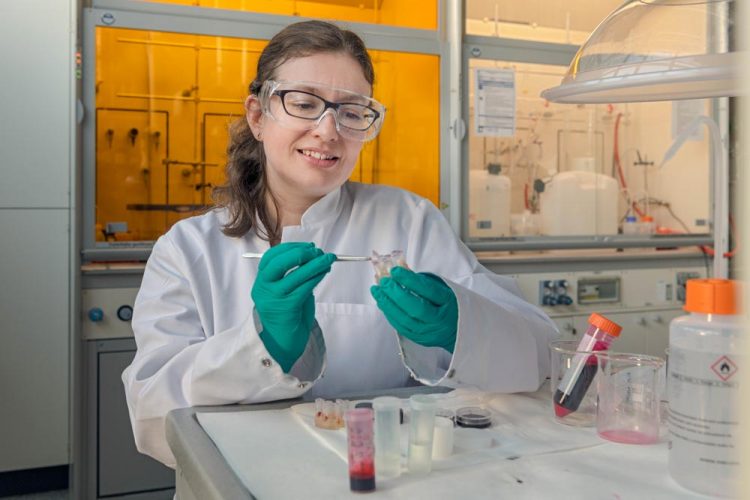Histology in 3D: new staining method enables Nano-CT imaging of tissue samples

Dr. Madleen Busse Chemist Dr. Madleen Busse has developed a staining method that enables scientists to conduct histological analysis in 3D. Free for use in reporting on the Nano-CT device with the copyright noted: (image: Heddergott / TUM).
Tissue sectioning is a routine procedure in hospitals, for instance to investigate tumors. As the name implies, it entails cutting samples of body tissue into thin slices, then staining them and examining them under a microscope.
Medical professionals have long dreamt of the possibility of examining the entire, three-dimensional tissue sample and not just the individual slices. The most obvious way forward here lies in computed tomography (CT) scanning – also a standard method used in everyday clinical workflows.
Previous limitations in resolution and contrast
Thus far, there have been two major hurdles to the realization of this goal. Firstly, the resolution of conventional CT scanners is too low. Today’s Micro- and Nano-CT systems are rarely suitable for use in frontline medicine. Some do not offer sufficiently high resolution, while others rely on radiation from large particle accelerators.
Secondly, soft tissue is notoriously difficult to examine using CT equipment. Samples have to be stained to render them visible in the first place. Stains for CT scanning are sometimes highly toxic, and they are also extremely time-consuming to apply. At times they modify the tissue to such an extent that further analysis is then impossible.
Successful collaboration between physics, chemistry and medicine
Now, however, scientists at TUM’s Munich School of BioEngineering (MSB) have solved both problems. In November 2017, Prof. Franz Pfeiffer and his team unveiled a Nano-CT system that delivers resolutions of up to 100 nanometers and is suitable for use in typical laboratory settings. In the current issue of the scientific journal PNAS, the cross-disciplinary research team from physics, chemistry and medicine also presents a staining method for histological examination with Nano-CT.
Compatibility with conventional methods
Using a mouse kidney, the scientists have successfully demonstrated that Nano-CT is able to generate 3D images that match the information granularity of tissue sections. At the core of the staining method lies eosin, a standard dye used in tissue sampling that was previously considered unsuitable for CT.
“Our approach included developing a special pre-treatment so that we can use eosin anyway,” outlines chemist Dr. Madleen Busse. The staining method is so time-efficient that it is also suited to everyday clinical workflows. “Another important benefit is that there are no problems using established methods to examine the tissue sample following the scan,” adds Busse.
Enhancement rather than replacement
In the next step, the researchers are looking to examine human tissue samples. However, CT histology is not set to replace conventional methods any time soon. For the moment, at least, the team views the new procedure as supplementary – for instance giving doctors additional insights into the three-dimensional distribution of cells and nuclei. Franz Pfeiffer also sees new opportunities here for basic medical research: “Alongside diagnostic applications, the non-destructive 3D examination enabled by Nano-CT could deliver new insights into the microscopic origins of widespread diseases such as cancer.”
Publication:
M. Busse, M. Müller, M. A. Kimm, S. Ferstl, S. Allner, K. Achterhold, J. Herzen, F. Pfeiffer, “Three-dimensional virtual histology enabled through cytoplasm-specific X-ray stain for microscopic and nanoscopic computed tomography”, PNAS (2018). DOI: 10.1073/pnas.1720862115
Further Information:
The Nano-CT system and staining method were developed at the Munich School of BioEngineering (MSB) This interdisciplinary TUM research center is Europe’s most multi-disciplinary university institution focused on the interface between medicine, engineering and natural sciences. Franz Pfeiffer, Professor of Biomedical Physics is Director of the MSB.
Munich School of BioEngineering: https://www.bioengineering.tum.de
Prof. Franz Pfeiffer: https://www.professoren.tum.de/en/pfeiffer-franz
Chair of Biomedical Physics: https://www.e17.ph.tum.de/en
High-resolution images:
https://mediatum.ub.tum.de/1432531
Contact:
Prof. Dr. Franz Pfeiffer
Chair of Biomedical Physics and Munich School of BioEngineering
Technical University of Munich
Tel.: +49 (89) 289 12551
franz.pfeiffer@tum.de
Media Contact
More Information:
http://www.tum.deAll latest news from the category: Life Sciences and Chemistry
Articles and reports from the Life Sciences and chemistry area deal with applied and basic research into modern biology, chemistry and human medicine.
Valuable information can be found on a range of life sciences fields including bacteriology, biochemistry, bionics, bioinformatics, biophysics, biotechnology, genetics, geobotany, human biology, marine biology, microbiology, molecular biology, cellular biology, zoology, bioinorganic chemistry, microchemistry and environmental chemistry.
Newest articles

First-of-its-kind study uses remote sensing to monitor plastic debris in rivers and lakes
Remote sensing creates a cost-effective solution to monitoring plastic pollution. A first-of-its-kind study from researchers at the University of Minnesota Twin Cities shows how remote sensing can help monitor and…

Laser-based artificial neuron mimics nerve cell functions at lightning speed
With a processing speed a billion times faster than nature, chip-based laser neuron could help advance AI tasks such as pattern recognition and sequence prediction. Researchers have developed a laser-based…

Optimising the processing of plastic waste
Just one look in the yellow bin reveals a colourful jumble of different types of plastic. However, the purer and more uniform plastic waste is, the easier it is to…



